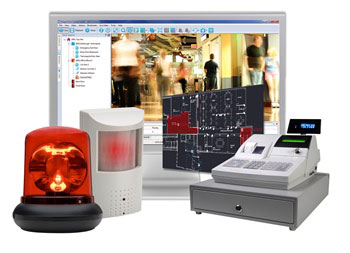
Why investing in IP technology will enhance ROI and future-proof your surveillance system
Security technology is developing rapidly, yet many organizations are still relying on out-of-date Analog technology to safeguard their staff and visitors. Multiple issues can be solved by upgrading your CCTV to an IP (Internet Protocol) system which transmits data over an internet or data network. Investing in new IP technology, when your current Analog system may be running OK for now, can be a tricky move to justify to your senior management; however the advantages that IP systems allow often far outweigh the financial spend, making a strong case for maximizing your return on investment (ROI).
For example, large sites such as universities, hospitals and airports using Analog systems have often suffered from costly building evacuations at the hands of thieves activating fire alarms in order to steal goods. The actual evacuations would cost the organizations large amounts of money each time they happened and often led to the perpetrators being able to get away. By upgrading to an IP system, simple integration features in the chosen Video Management Software allow fire alarms to show in the CCTV system. This means an operator can immediately be presented with video of the scene before and after alarm activation. If it is a false alarm, the organization can avoid evacuation, allowing the suspect to be detained and stolen goods to be recovered. One large UK site that upgraded to an IP system from IndigoVision was thus able to achieve their return on investment within 9 months.
There is no redundancy built into Analog CCTV systems, so if a failure occurs in the system, the control room no longer has the capability to view live or recorded video. On an IP system, footage can still be viewed from any authorized device on the network, which can help to avoid serious incidents when there has been an issue in the control room. If the electricity is cut off at your premises for the purpose of someone committing a crime, being able to access live video from another network device can enable you to catch the suspect and prevent more serious consequences.
There are clear benefits to IP surveillance systems which is why many organizations have already made the switch. Before starting to plan a system’s migration from Analog to IP, it’s important to understand the considerations and requirements necessary to make this change by discussing your objectives with a security expert.
How do I justify investing in an IP system?
More Robust Evidence:
IP surveillance systems provide the opportunity to incorporate high definition (HD) cameras with a much superior image quality when compared to their Analog equivalent. You can reduce hardware requirements and cover a larger area on your site with fewer HD cameras, which can be remotely controlled from a control room. The improved image resolution enables security operators to more closely follow footage and identify suspects on camera, allowing for better and faster decision-making to safeguard both people and property.
The lower quality of the cameras in Analog systems can limit the ability to secure criminal prosecutions: security operators may find that they can isolate an image of the suspect of a crime from a camera, but the image is at such a low resolution that it’s impossible to positively identify them. Therefore you can achieve cost-savings from upgrading to an IP system, as images captured from your cameras are of sufficient quality to be used as evidence for law enforcement: helping to catch suspects and secure prosecutions. It can also help to avoid expensive litigation: if someone has fallen down the stairs on your premises and are threatening to sue because the steps are in need of repair, you can immediately locate camera footage from the required time and date to prove whether their case is valid or not. If the individual was at fault for the accident, high quality still images from your IP cameras can be used to save a potentially lengthy and expensive lawsuit.
Integrations to make your system more intelligent:
Analog cameras are unable to integrate with analytics software and Artificial Intelligence, a tool which is used in IP security systems to streamline operations and increase efficiency. When an incident occurs such as a theft, operators using an Analog system have to manually search through footage to find the appearance and whereabouts of a suspect, which can cause delays when seconds count to react and catch a perpetrator. Analytics features such as motion search, tripwire and face detection, can be integrated with IP cameras: these tools can reduce the time for operators to search video, making it easier to locate suspects because the system will automatically search for appearances of individuals across its network of cameras to isolate their most recent whereabouts. This information can then be passed to security guards or police on the premises to help to catch the criminals.
There are also an array of advantages to integrating IP cameras with other IT systems, such as access control, building management, intruder management and fire alarms. For example, integrating your security system with access control and License Plate Recognition (LPR) analytics software can be configured for an organization’s staff car park, to automatically allow entry for cars with authorized license plates. This removes a manual and repetitive task for security operators and speeds up entry into the car park for employees each morning.
Analog technology also causes constraints in terms of surveillance system configuration: each camera is connected through a wire to a monitor in a control room creating hot, cramped control rooms filled with hardware. More electricity is required to power cooling units to make the environment more comfortable for staff and to keep the equipment from overheating. On the other hand, IP cameras can be connected to switches and can simultaneously be viewed on one monitor, creating a much more efficient system that saves on physical space and power consumption, and which is also more comfortable for people working in the Control Room.
Security managers operating an Analog system often find that it’s difficult to source a replacement when a piece of hardware fails. This is because a lot of Analog technology is end-of-life, which results in components being sold at a premium because they are so scarce in the marketplace. IP systems operate using the latest technology and also use standard PC server hardware rather than proprietary equipment, so replacement parts are in plentiful supply often at a lower cost, helping you to get your system back to full working order as quickly as possible.
Further cost efficiencies can be found in IP systems due to the ability to remote access live video: authorized users can access real-time video at any time from any authorized device on the network. This means that control of multiple locations (such as airport terminals) can be centralized into one main Control Room, removing the need to duplicate equipment and staff.
-
The extended capabilities of IP systems compared with Analog technology cannot be argued with; however it can be more difficult to prove the worth of investing in a brand-new system. It’s important to understand your organization’s operational requirements and objectives before you start, as well as the different options available for upgrading (such as hybrid Analog/IP variants).








